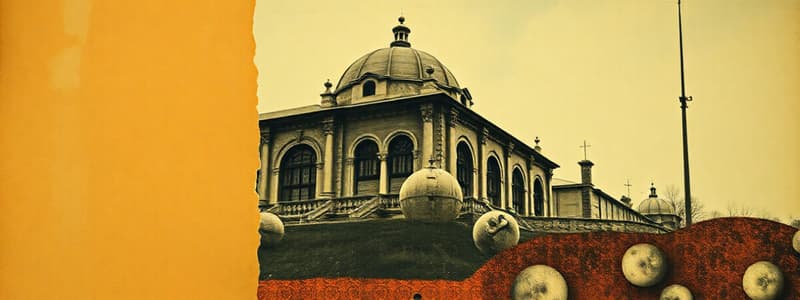Podcast
Questions and Answers
What role does the director play in film production?
What role does the director play in film production?
- They manage the film budget.
- They convey meaning and personal vision. (correct)
- They handle distribution negotiations.
- They are primarily responsible for marketing.
Which technique alters the viewer's perception of space and time in film?
Which technique alters the viewer's perception of space and time in film?
- Editing (correct)
- Lighting design
- Mis-en-scene
- Costuming
What was the significance of the Kodak Revolution in photography?
What was the significance of the Kodak Revolution in photography?
- It was the first to use film in a camera.
- It introduced the daguerreotype technique.
- It made photography accessible to the general public. (correct)
- It allowed for high-speed shutter releases.
Which step comes last in the process of turning an idea into a film exhibition?
Which step comes last in the process of turning an idea into a film exhibition?
What is a major characteristic of Bollywood in the film industry?
What is a major characteristic of Bollywood in the film industry?
What was the primary purpose of the calotype process introduced by William Henry Fox Talbot?
What was the primary purpose of the calotype process introduced by William Henry Fox Talbot?
Which of the following best describes 'mis-en-scene' in filmmaking?
Which of the following best describes 'mis-en-scene' in filmmaking?
What was the first commercially successful photographic process developed?
What was the first commercially successful photographic process developed?
Flashcards
Film's Emotional Impact
Film's Emotional Impact
Film is a powerful medium that evokes strong emotions in viewers.
Bringing Stories to Life
Bringing Stories to Life
Filmmakers use various techniques to create believable worlds and characters, bringing stories to life.
Quick Cuts in Editing
Quick Cuts in Editing
Quick cuts in editing create a sense of urgency and danger, drawing the viewers into the story.
Manipulating Space and Time
Manipulating Space and Time
Signup and view all the flashcards
The Film Director
The Film Director
Signup and view all the flashcards
Mis-en-scène
Mis-en-scène
Signup and view all the flashcards
The Camera Obscura
The Camera Obscura
Signup and view all the flashcards
The Daguerreotype
The Daguerreotype
Signup and view all the flashcards
Study Notes
Film Studies
- Film is a powerful emotional experience
- Filmmakers bring stories to life using quick cuts to create a sense of danger and editing to manipulate time and space
- Directors convey meaning via mise-en-scene (setting, lighting, costumes, makeup) and cinematography, editing, and sound
- Film's creation involves 12 steps, from initial idea to theatrical exhibition by distributors
Photography
- Photography is about interpreting reality, not just copying
- Camera obscura: a darkened box with a small opening that projects an inverted image onto a surface
- Daguerreotype: first successful photographic process, producing images on a polished metal plate
- Calotype: photographic process that enables images to be recorded on paper, invented by William Fox Talbot
- Kodak revolution: George Eastman's creation of the first roll-film hand camera, making photography more accessible
- Digital Single Lens Reflex (DSLR) cameras use a mirror to reflect light onto the sensor
- Lenses affect how subjects are viewed and interact with the image
- Light meters adjust shutter speed and aperture (opening) for appropriate exposure
- Photography involves interpreting reality and expressing personal visions through diverse techniques and equipment
Studying That Suits You
Use AI to generate personalized quizzes and flashcards to suit your learning preferences.




